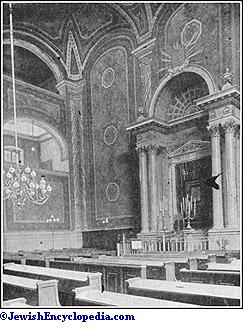Arad (Alt-Arad)
 From Jewish Encyclopedia (1906)
From Jewish Encyclopedia (1906) Arad (Alt-Arad):
By: Gotthard Deutsch , Eduard Neumann
- Early History.
- Aron Chorln and Moses Hirschl.
- Diversity of Trades.

A royal free city and market town of Hungary, on the Maros, 145 miles southeast of Budapest. Among the Jewish communities of Hungary that of Arad holds a prominent place. Its history begins in the first half of the eighteenth century. The passport issued by Lieut. Field-Marshal Baron Cosa, May 1, 1717, to two Jews residing in the suburbs, is, so far as is known, the oldest historical document containing information concerning the Jewish community there. In 1741 there lived in Arad only one Jew, named Mandel, who purchased the right to sell, at first groceries, and then liquors, under the protection of Colonel Horvath of the boundary guard. Other Jews soon settled there. A census taken in 1743 showed that six of them lived in their own houses. The congregation, together with its associated "Ḥebrah Ḳaddishah," was organized about this time. In 1754 there were 24 Jewish families residing in Arad; among them Jacob Isaac, rabbi and teacher, with an annual salary of 36 florins. The year 1789 marks the turning-point in the history of the Arad community.
Aron Chorln and Moses Hirschl.In May of that year Aron Chorin entered upon his duties as rabbi of the congregation. The whole history of the community and its struggles, its successes, and its renown thenceforth center in him. With touching devotion and patriarchal sentiment he applied himself to its elevation, and organized most of the benevolent institutions that are its pride to-day. Another man who, with the rabbi, deserved well of the congregation was Moses Hirschl, who for several decades devoted his attention mainly to its educational interests. Together with the principal, Lazar Skreinka, he succeeded in raising the intellectual grade of the school to the satisfaction of the governmental authorities. Of especial importance, however, for the true development of the congregation was the success attending Chorin's efforts to induce the youths in the community to acquire a knowledgeof handicrafts. The Arad congregation led those of Hungary, both in the number of its mechanics and in the variety of trades represented. The inspiration of the movement originated with Chorin, who in this matter took his stand upon Talmudic precepts. "From this congregation," he wrote in 1831, "seventy-eight young men have gone forth to follow various handicrafts, and in addition several have devoted themselves to such professions as the law permits. Some of these latter already have large practises as physicians and surgeons."
Diversity of Trades.In a letter to Gabriel Ullmann, president of the Pesth congregation, he names the trades that were followed by the Jews of Arad: there were goldsmiths, tanners, confectioners, furriers, coopers, watchcasemakers, braid-makers, soap-boilers, horseshoe-makers, smiths, locksmiths, gunsmiths, bookbinders, painters, tailors, pipe-mounters, glaziers, shoemakers, saddlers, etc.
Philanthropic interests were taken charge of by the Humanitätsverein, founded in 1830, and enlarged later by a women's society with similar aims; their special charge being the excellent Jewish hospital, a creation of the Ḥebrah Ḳaddishah, which was first organized in 1790 by Chorin. After Chorin's death, 1844, the Arad congregation, which in 1839 aggregated 812 souls, called Jacob Steinhardt as their temporary rabbi and school-superintendent. A year and a half later he became chief rabbi, and was followed in 1885 by Alexander Rosenberg, previously rabbi in Kaposvar. During the whole of the last half of the nineteenth century the Arad congregation developed and prospered. All branches of congregational activity kept pace with the numerical growth of the congregation, which in 1860 aggregated 2,700 souls, and which since then has doubled. The affairs of the congregation are conducted according to well-devised rules; schools have been reorganized; additional benevolent institutions have been established, of which the Orphan Home deserves especial mention: and a home for pensioned employees of the congregation has been opened.
- Jahrbuch für die Israelitischen Kultusgemeinden in Ungarn, i. 144;
- Ben-Chananja, vi. 133 et seq.
Categories: [Jewish encyclopedia 1906]
↧ Download as ZWI file | Last modified: 09/04/2022 17:53:32 | 24 views
☰ Source: https://www.jewishencyclopedia.com/articles/1693-arad-alt-arad.html | License: Public domain
 ZWI signed:
ZWI signed: KSF
KSF